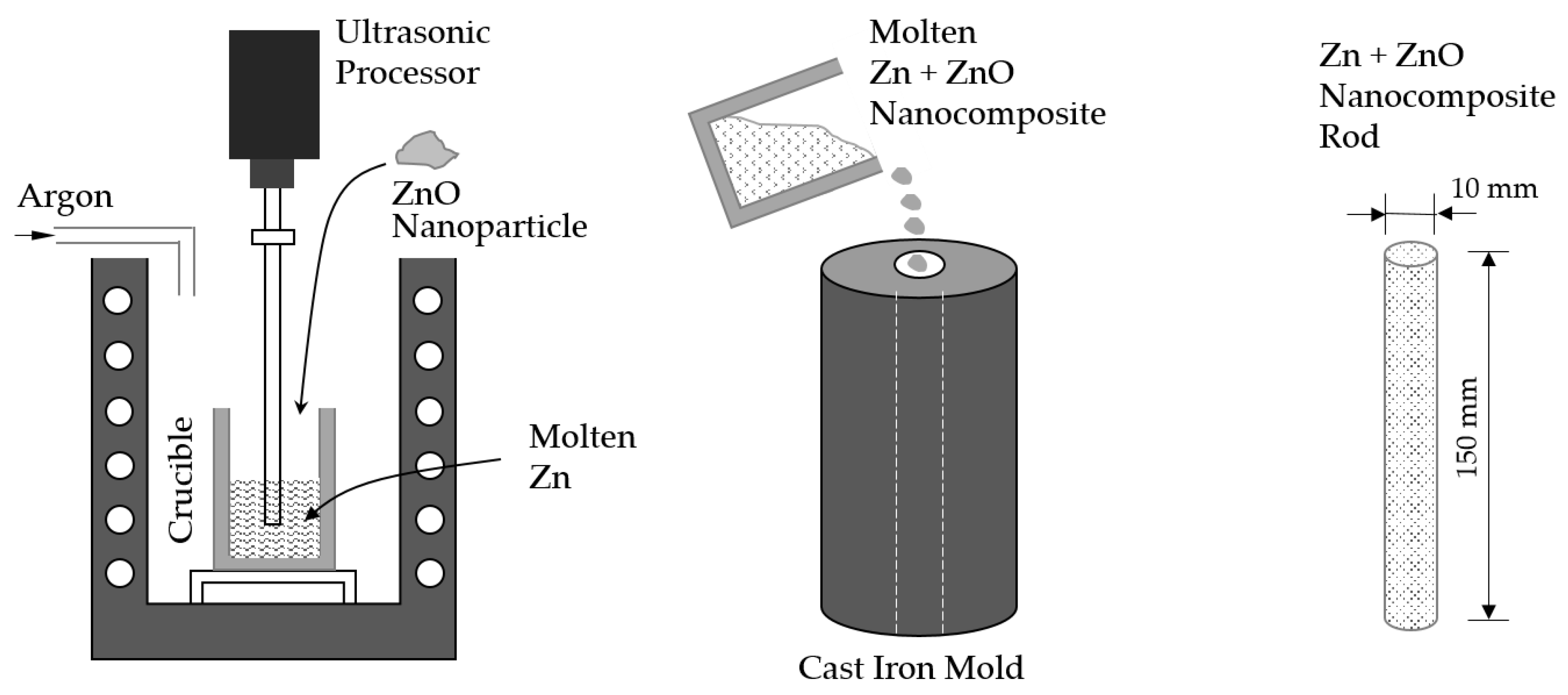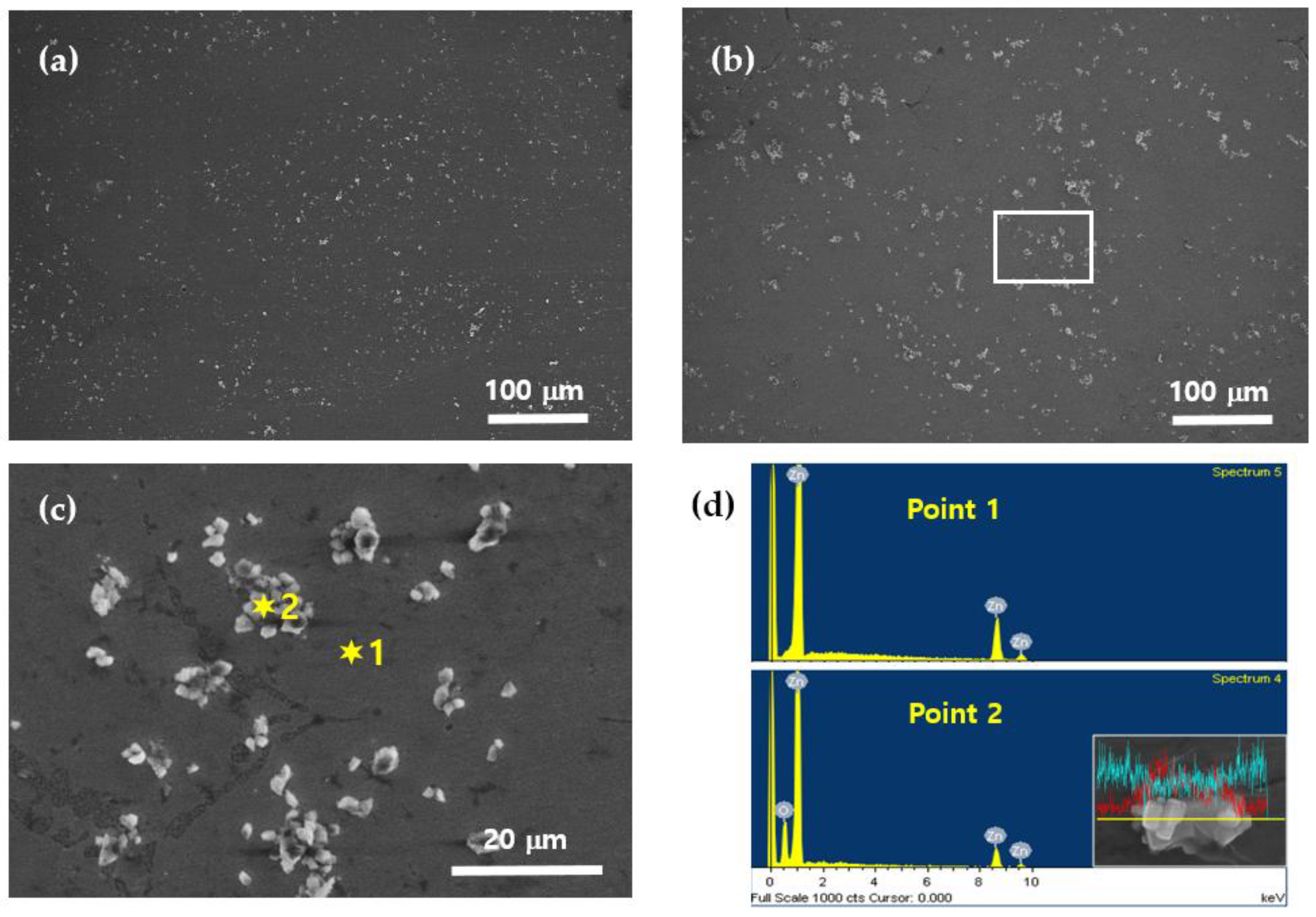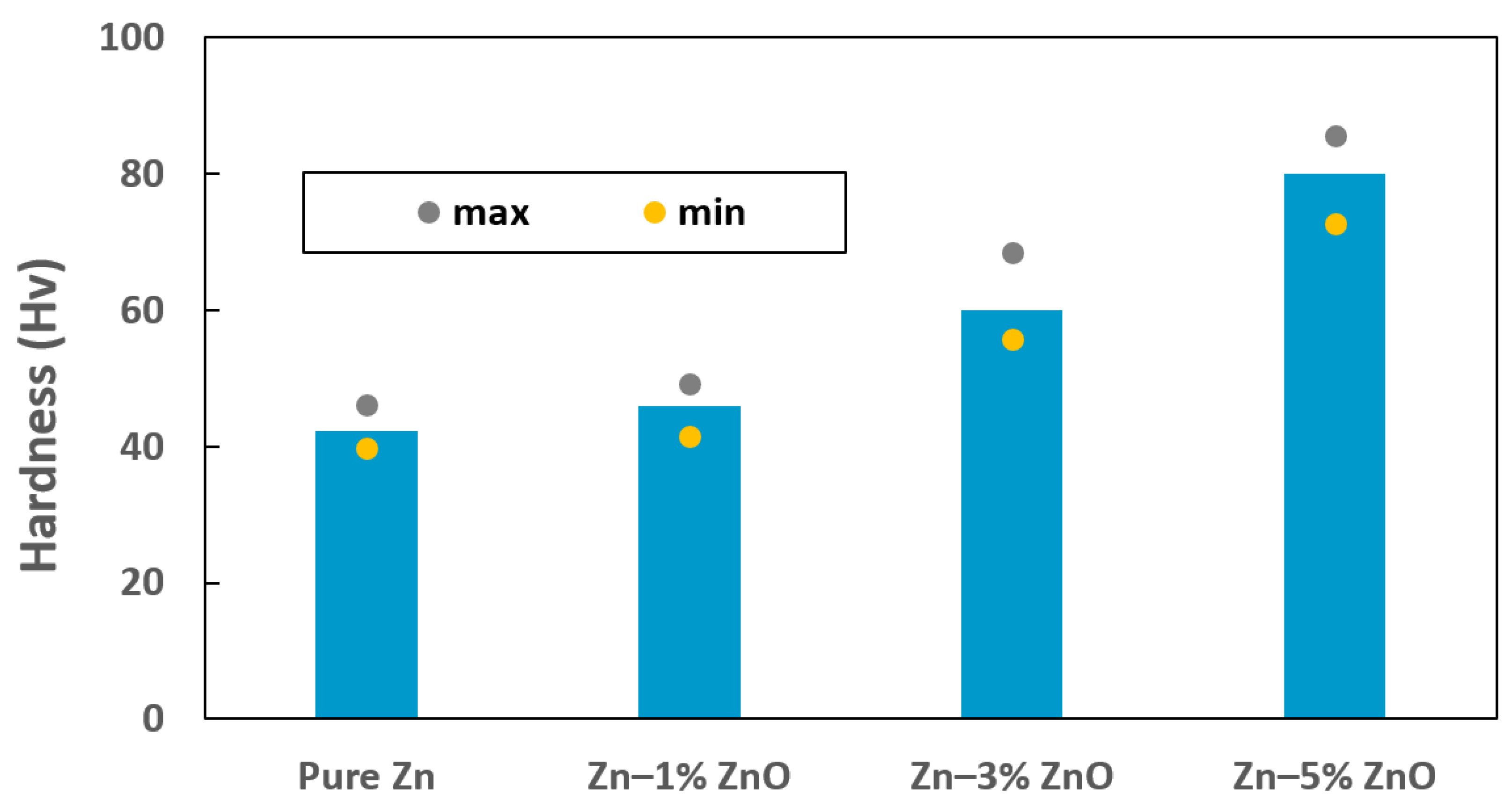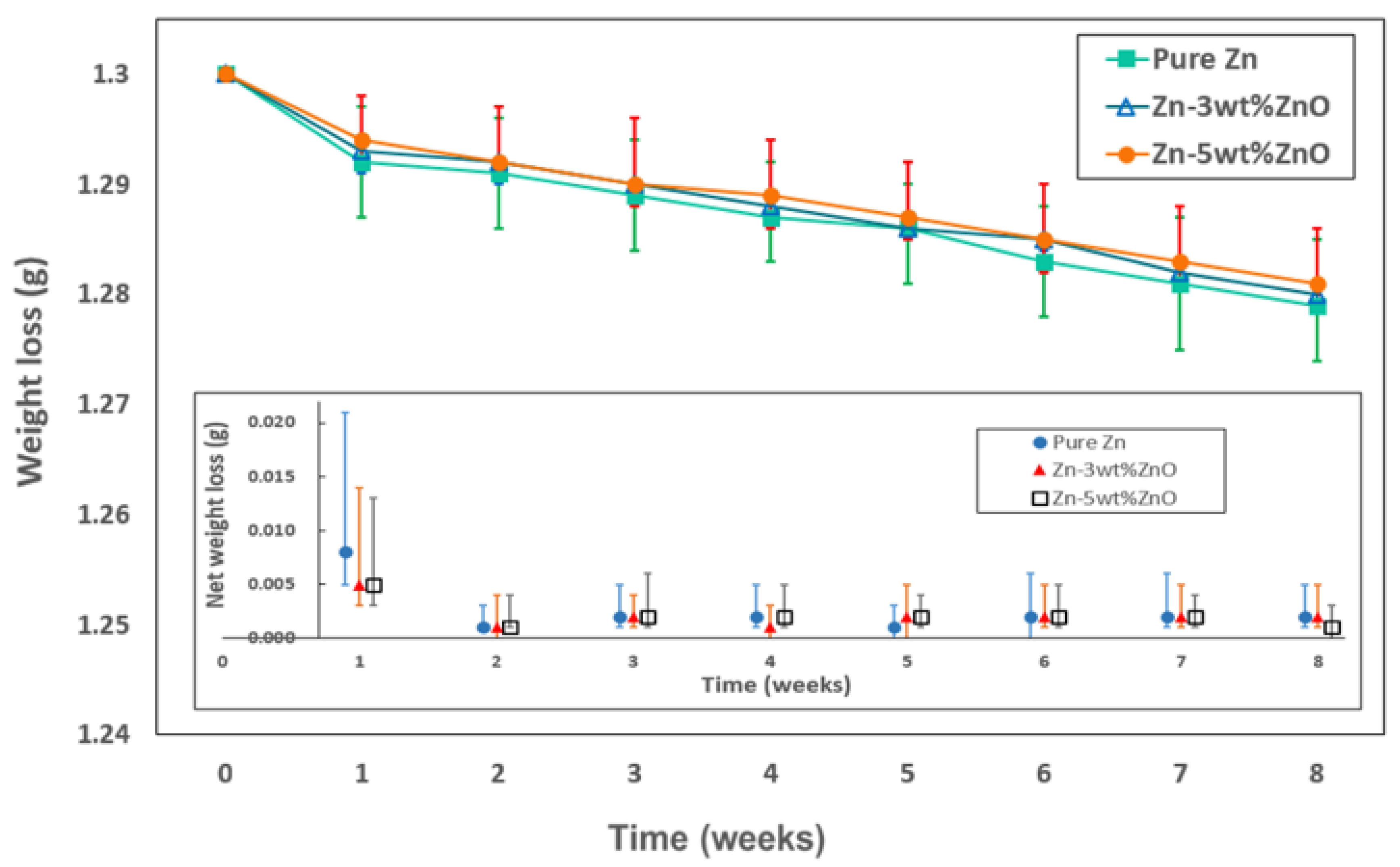Development and Characterization of Zn-ZnO Nanocomposites for Enhanced Biodegradable Material Properties
Abstract
1. Introduction
2. Materials and Methods
2.1. Fabrication of Zn-ZnO Nanocomposites
2.2. Characterization of Zn-ZnO Nanocomposites
2.3. Degradation Method
3. Results and Discussion
3.1. Morphology
3.2. Mechanical Properties of Zn–ZnO Nanocomposites
3.3. Degradation of Zn–ZnO Nanocomposites
4. Conclusions
Author Contributions
Funding
Institutional Review Board Statement
Informed Consent Statement
Data Availability Statement
Conflicts of Interest
References
- Levy, G.; Goldman, J.; Aghion, E. The prospects of zinc as a structural material for biodegradable implants-a review paper. Metals 2017, 7, 402. [Google Scholar] [CrossRef]
- Venezuela, J.; Dargusch, M. The influence of alloying and fabrication techniques on the mechanical properties, biodegradability and biocompatibility of zinc: A comprehensive review. Acta Biomater. 2019, 87, 1–40. [Google Scholar] [CrossRef] [PubMed]
- Bowen, P.; Shearier, S.; Zhao, S.; Guillory, S., II; Zhao, F.; Goldman, J.; Drelich, J. Biodegradable metals for cardiovascular stents: From clinical concerns to recent Zn-alloys. Adv. Healthcare Mater. 2016, 5, 1121–1140. [Google Scholar] [CrossRef] [PubMed]
- Liu, Y.; Lu, B.; Cai, Z. Recent progress on Mg- and Zn-based alloys for biodegradable vascular stent applications. J. Nanomater. 2019, 2019, 1310792. [Google Scholar] [CrossRef]
- Zhen, Z.; Xi, T.; Zheng, Y. A review on in vitro corrosion performance test of biodegradable metallic materials. Trans. Nonferrous Met. Soc. China 2013, 23, 2283–2293. [Google Scholar] [CrossRef]
- Yan, Y.; Chu, X.; Luo, X.; Xu, X.; Zhang, Y.; Dai, Y.; Li, D.; Chen, L.; Xiao, T.; Yu, K. A homogeneous microstructural Mg-based matrix model for orthopedic application with generating uniform and smooth corrosion product layer in Ringer’s solution: Study on biodegradable behavior of Mg-Zn alloys prepared by powder metallurgy as a case. J. Magnes. Alloys 2021, 9, 225–240. [Google Scholar] [CrossRef]
- Dai, Y.; Liu, H.; Tang, Y.; Xu, X.; Long, H.; Yan, Y.; Luo, Z.; Zhang, Y.; Yu, K.; Zhu, Y. A potential biodegradable Mg-Y-Ag implant with strengthened antimicrobial properties in orthopedic applications. Metals 2018, 8, 948. [Google Scholar] [CrossRef]
- Badisha, V.; Shaik, S.; Dumpala, R.; Sunil, B. Developing Mg-Zn surface alloy by friction surface alloying: In vitro degradation studies in simulated body fluids. Int. J. Miner. Metall. Mater. 2020, 27, 962–969. [Google Scholar] [CrossRef]
- Venkatesh, B.; Harish, B. Mechanical properties of metal matrix composites (Al/SiCp) particles produced by powder metallurgy. Int. J. Eng. Res. Gen. Sci. 2015, 3, 1277–1284. [Google Scholar]
- Hwang, I.; Guan, Z.; Li, X. Scalable manufacturing of zinc-tungsten carbide nanocomposites. Procedia Manuf. 2018, 26, 140–145. [Google Scholar] [CrossRef]
- Ilkhechi, N.; Mozammel, M.; Khosroushahi, A. Antifungal effects of ZnO, TiO2 and ZnO-TiO2 nanostructures on aspergillus flavus. Pestic. Biochem. Physiol. 2021, 176, 104869–104876. [Google Scholar] [CrossRef] [PubMed]
- Darzi, J.; Mahjoub, S. Investigation of phase transformations and photocatalytic properties of sol-gel prepared nanostructured ZnO/TiO2 composites. J. Alloys Compd. 2009, 486, 805–808. [Google Scholar] [CrossRef]
- Zhou, D.; Qiu, F.; Wang, H.; Jiang, Q. Manufacture of nano-sized particle-reinforced metal matrix composites: A review. Acta Metall. Sin. 2014, 27, 798–805. [Google Scholar] [CrossRef]
- Lloyd, D. Particle reinforced aluminum and magnesium matrix composites. Int. Mater. Rev. 1994, 39, 1–23. [Google Scholar] [CrossRef]
- Nguyen, D.D.; Lai, J.-Y. Synthesis, bioactive properties, and biomedical applicatioins of instrinsically therapeutic nanoparticles for disease treatment. Chem. Eng. J. 2022, 435, 134970. [Google Scholar] [CrossRef]
- Arunachalam, R.; Krishnan, P.; Muraliraja, R. A review on the production of metal matrix composites through stir casting–furnace design, properties, challenges, and research opportunities. J. Manuf. Process 2019, 42, 213–245. [Google Scholar]
- Kaczmar, J.; Pietrzak, K.; Wlosinski, W. The production and application of metal matrix composite materials. J. Mater. Process. Technol. 2000, 106, 58–67. [Google Scholar] [CrossRef]
- Dash, K.; Chaira, D.; Ray, B. Synthesis and characterization of aluminum-alumina micro- and nano-composites by spark plasma sintering. Mater. Res. Bull. 2013, 48, 2535–2542. [Google Scholar] [CrossRef]
- Sun, B.; Cai, Q.; Cheng, J.; Zhao, B. Effect of TiN nanoparticles on microstructure and properties of Al2024-TiN nanocomposite by high energy milling and spark plasma sintering. J. Alloys Compd. 2017, 726, 638–650. [Google Scholar]
- Kandpal, B.; Kumar, J.; Singh, H. Manufacturing and technological challenges in stir casting of metal matrix composites—A review. Mater. Today Proc. 2018, 5, 5–10. [Google Scholar] [CrossRef]
- Rohatgi, P.; Asthana, R.; Das, S. Solidification, structures, and properties of cast metal-ceramic particle composites. Int. Mater. Rev. 1986, 31, 115–139. [Google Scholar] [CrossRef]
- Nunes, P.; Costa, D.; Fortunato, E.; Martins, R. Performances presented by zinc oxide thin films deposited by r.f. magnetron sputtering. Vacuum 2002, 64, 293–297. [Google Scholar] [CrossRef]
- Takada, S. Relation between optical property and crystallinity of ZnO thin films prepared by rf magnetron sputtering. J. Appl. Phys. 1993, 73, 4739–4742. [Google Scholar] [CrossRef]
- Lee, N.; Ko, W.; Hsueh, P. Nanoparticles in the treatment of infections caused by multidrug-resistant organisms. Front. Pharmacol. 2019, 10, 1153–1162. [Google Scholar] [CrossRef]
- ASTM E8/E8M; Standard Test Methods for Tension Testing of Metallic Materials. ASTM International: West Conshohocken, PA, USA, 2022.
- Moustafa, E.; Taha, M. The effect of mono and hybrid additives of ceramic nanoparticles on the tribological behavior and mechanical characterstics of an Al-based composite matrix produced by friction stir processing. Nanomaterials 2023, 13, 2148. [Google Scholar] [CrossRef]
- Papanikolaou, S.; Shanthraj, P.; Thibault, J.; Woodward, C.; Roters, F. Brittle to quasi-brittle transition and crack initiation precursors in crystals with structural inhomogeneities. J. Mater. Sci. Mater. Theory 2019, 3, 5. [Google Scholar] [CrossRef]






| Zn Rod (g) | Zn Nanoparticle (g) | ZnO Nanoparticle (g) | Total Weight (g) | |
|---|---|---|---|---|
| Pure Zn | 130.0 | 0.0 | 0.0 | 130.0 |
| Zn–1% ZnO | 130.0 | 2.0 | 1.4 | 133.4 |
| Zn–3% ZnO | 130.0 | 2.0 | 4.2 | 136.2 |
| Zn–5% ZnO | 130.0 | 2.0 | 7.0 | 139.0 |
| Pure Zn | Zn–1% ZnO | Zn–3% ZnO | Zn–5% ZnO | |
|---|---|---|---|---|
| 1 | 40.4 | 45.1 | 59.6 | 85.5 |
| 2 | 46.1 | 46.3 | 57.6 | 84.3 |
| 3 | 41.2 | 49.2 | 55.8 | 79.1 |
| 4 | 39.7 | 41.4 | 68.4 | 78.4 |
| 5 | 39.7 | 47.8 | 58.4 | 72.7 |
| Average | 42.3 | 46.0 | 60.0 | 80.0 |
| Standard deviation | 2.2 | 2.4 | 4.0 | 4.2 |
Disclaimer/Publisher’s Note: The statements, opinions and data contained in all publications are solely those of the individual author(s) and contributor(s) and not of MDPI and/or the editor(s). MDPI and/or the editor(s) disclaim responsibility for any injury to people or property resulting from any ideas, methods, instructions or products referred to in the content. |
© 2025 by the authors. Licensee MDPI, Basel, Switzerland. This article is an open access article distributed under the terms and conditions of the Creative Commons Attribution (CC BY) license (https://creativecommons.org/licenses/by/4.0/).
Share and Cite
Shin, J.; Choi, J.; Choi, Y.W.; Kim, S.; Hwang, I. Development and Characterization of Zn-ZnO Nanocomposites for Enhanced Biodegradable Material Properties. Materials 2025, 18, 938. https://doi.org/10.3390/ma18050938
Shin J, Choi J, Choi YW, Kim S, Hwang I. Development and Characterization of Zn-ZnO Nanocomposites for Enhanced Biodegradable Material Properties. Materials. 2025; 18(5):938. https://doi.org/10.3390/ma18050938
Chicago/Turabian StyleShin, Johngeon, Jaewon Choi, Yong Whan Choi, Seongsoo Kim, and Injoo Hwang. 2025. "Development and Characterization of Zn-ZnO Nanocomposites for Enhanced Biodegradable Material Properties" Materials 18, no. 5: 938. https://doi.org/10.3390/ma18050938
APA StyleShin, J., Choi, J., Choi, Y. W., Kim, S., & Hwang, I. (2025). Development and Characterization of Zn-ZnO Nanocomposites for Enhanced Biodegradable Material Properties. Materials, 18(5), 938. https://doi.org/10.3390/ma18050938





